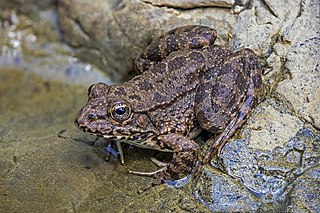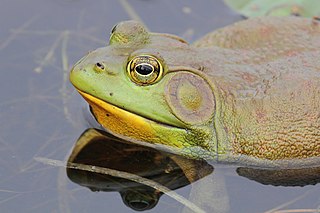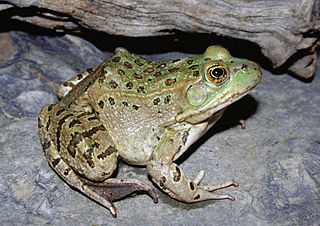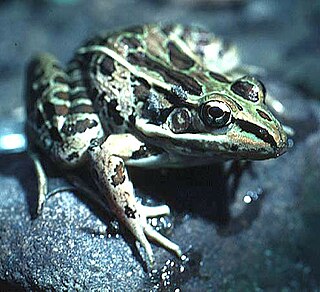
True frogs is the common name for the frog family Ranidae. They have the widest distribution of any frog family. They are abundant throughout most of the world, occurring on all continents except Antarctica. The true frogs are present in North America, northern South America, Europe, Africa, and Asia. The Asian range extends across the East Indies to New Guinea and a single species, the Australian wood frog, has spread into the far north of Australia.

Leopard frog is a generic name used to refer to various species in the true frog genus Lithobates. They all have similar coloration: brown or green with spots that form a leopard pattern. They are distinguished by their distribution and behavioral, morphological, and genetic differences. The range of the various species of leopard frogs extends from the Hudson Bay in Canada, throughout the United States, throughout Mexico and other parts of Central America, and possibly the very northern section of South America.

Lithobates pipiens or Rana pipiens, commonly known as the northern leopard frog, is a species of leopard frog from the true frog family, native to parts of Canada and the United States. It is the state amphibian of Minnesota and Vermont.

Rana is a genus of frogs commonly known as the Holarctic true frogs, pond frogs or brown frogs. Members of this genus are found through much of Eurasia and western North America. Many other genera were formerly included here. These true frogs are usually largish species characterized by their slim waists and wrinkled skin; many have thin ridges running along their backs, but they generally lack "warts" as in typical toads. They are excellent jumpers due to their long, slender legs. The typical webbing found on their hind feet allows for easy movement through water. Coloration is mostly greens and browns above, with darker and yellowish spots.

The pickerel frog is a small North American frog, characterized by the appearance of seemingly "hand-drawn" squares on its dorsal surface.

Lithobates sphenocephalus or Rana sphenocephala, commonly known as the southern leopard frog, is a medium-sized anuran in the family Ranidae. It is native to eastern North America from Kansas to New York to Florida. It is also an introduced species in some areas. This species lives in cool, clear water in the north, whereas in the south it occurs in warmer turbid and murky waters of coastal and floodplain swamps, twilight zones of caves, and abandoned mines.

The Plains leopard frog is a spotted frog found in North America. It is sometimes referred to as Blair's leopard frog, named after the noted zoologist and University of Texas professor, Dr. W. Frank Blair.

The Vegas Valley leopard frog, also known as the Las Vegas leopard frog, is an extinct species of frog. It once occurred in the Las Vegas Valley, as well as Tule Springs, Clark County, southern Nevada in the United States, at elevations between 370 and 760 m. It was believed to be the only frog endemic to the United States to have become extinct in modern times.

Lithobates is a genus of true frogs, of the family Ranidae. The name is derived from litho- (stone) and the Greek bates, meaning one that treads on rock, or rock climber.

The Chiricahua leopard frog is a species of frog in the family Ranidae, the true frogs.

Forrer's grass frog or Forrer's leopard frog is a species of frog in the family Ranidae found in Mexico and Central America through Guatemala, El Salvador, Honduras, and Nicaragua to Costa Rica. It is a widespread and common frog found in lowland and seasonal tropical forests. It can also adapt to man-made habitats such as flooded agricultural lands and other water content systems. Reproduction requires permanent pools and lagoons.
Moore's frog is a species of frog in the true frog family (Ranidae). It is endemic to the Sierra Madre Oriental of Mexico.
The Guatemala plateau frog is a species of frog in the family Ranidae. It occurs in Guatemala and southern Mexico. It is impossible to morphologically distinguish this species from Lithobates forreri and Lithobates brownorum, and the validity of it has been questioned. It is an uncommon frog that inhabits cloud forests, including degraded forest, and grassland. Breeding takes place in streams and small temporary ponds. It is threatened by habitat degradation caused by agricultural encroachment, wood extraction, human settlement, and water pollution.
The smooth-backed frog is a species of frog in the family Ranidae endemic to Mexico.

The showy leopard frog is a species of frog in the family Ranidae endemic to Mexico.

Vaillant's frog is a species of frog in the family Ranidae found in Central America. Its natural habitats are subtropical or tropical dry forests, subtropical or tropical moist lowland forests, subtropical or tropical swamps, rivers, swamps, freshwater lakes, intermittent freshwater lakes, freshwater marshes, intermittent freshwater marshes, rural gardens, heavily degraded former forests, water storage areas, ponds, and canals and ditches.

The lowland leopard frog is a species of frog in the family Ranidae that is found in Mexico and the United States.

The Atlantic Coast leopard frog is a species of amphibian that is endemic to the United States. As a member of the genus Ranasensu lato, it is classified as a true frog, with typical smooth skin and a narrow waist. Its range stretches along the northern part of Eastern Seaboard, from Connecticut to North Carolina. The species takes its common name from the speckles on its legs and back reminiscent of a leopard pattern.
















